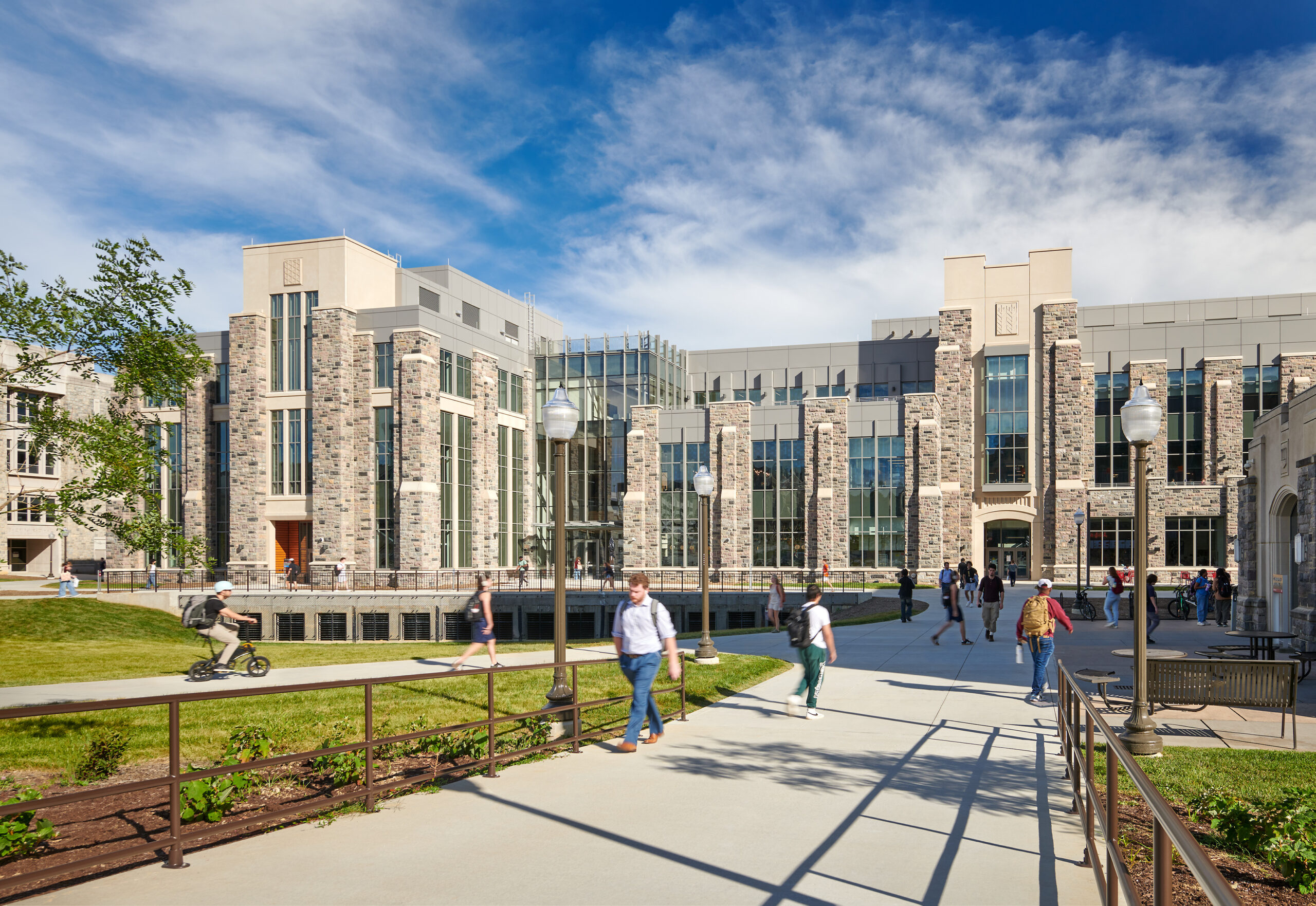By Lindsey Coulter
Construction programs and dining halls don’t often go hand in hand. However, Virginia Polytechnic Institute and State University (Virginia Tech) saw considerable cost and efficiency benefits by co-locating two otherwise disparate spaces in the beautiful new $67 million Hitt Hall. The structure, spanning approximately 101,000 square feet, officially debuted in September and has already transformed the University’s North Academic District.
The innovative Hitt Hall houses much needed academic and administrative spaces and multiple new dining options; however, it is anchored by the well-regarded Myers-Lawson School of Construction. As the base for Virginia Tech’s building construction and construction engineering and management programs, expectations for design, construction and overall quality were high. The team of national design firm Cooper Carry and construction firm W.M. Jordan of Richmond, Va., were eager for the challenge to put their skills on full display, inspiring the next generation of construction and engineering professionals — while giving all Virginia Tech students a modern, comfortable spot to rest, study and grab a bite.
Design and Cost Efficiency
Co-locating learning spaces, administrative spaces and dining facilities within Hitt Hall immediately added value and efficiency to the project. Importantly, the diversity of uses and functions allowed the University to utilize internal, state and donor funding for the project, resulting in greater cost efficiency. The building was named for the Hitt family, owners of the national general construction firm HITT Contracting, bringing an even greater sense of symmetry and purpose to the structure.
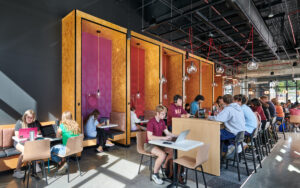
“Had each program used its individual funding source, more money would have been spent on circulation, stairs, elevators and hallways — as well as on unstructured [spaces] and building envelope, which would have resulted in less program space,” said Brent Amos, principal and lead of Cooper Carry’s Science + Technology Studio.
Due to the diversity of spaces, needs and functions within the facility, the Cooper Carry team approached the design and programming process differently than it might have with a more standard project. Utilizing its mixed-use ecosystem, the team engaged experts in its architecture, interiors, lab and classroom planning, environmental graphics, food and beverage, and branding teams at the earliest phases of the project. This approach led to an integrated and cohesive design that married all design disciplines.
“Building construction is becoming more and more expensive. So, it makes sense to have mixed-use facilities that share the cost of general infrastructure, so that each program can be more cost-efficient,” Amos said. “We believe this trend will continue to stretch dollars and maximize efficiency, as will adaptive reuse and renovations.”
Creating Spatial Identities
Another consideration for the design team was ensuring each space and function within the expansive, fully ADA-compliant building had its own sense of identity, while still offering visual flow and harmony.
“As a nationally ranked and world-renowned school, the Myers Lawson School of Construction required its own identity,” Amos said. “Similarly, Virginia Tech’s dining group is consistently ranked as a top university dining destination. As such, there is a distinctive exterior design for two primary functions.”
Originally the project was planned using a design-build approach, meaning the bridging documents had the design as two separate buildings with a bridge. However, budget constraints led to the need for a more efficient layout with a link connecting the two buildings. The design also evolved to be a more modern interpretation of collegiate gothic architecture, with large windows that were paired on multiple floors.
The ultimate design comprises two wings that are connected by a glass section that serves as a central link between the otherwise disparate spaces. From the exterior, the structure was designed to read as two separate buildings but also read as a singular cohesive design.
Educating New Construction Professionals
The development of Hitt Hall will enable Virginia Tech to significantly expand undergraduate enrollment in the Construction Engineering and Management and Building Construction programs, attracting students who are excited to learn about the latest innovations within the construction industry. With this goal and mission in mind, the Myers Lawson School of Construction, located in the northern portion of Hitt Hall, was designed to serve as both a space for education and a research and teaching tool itself.
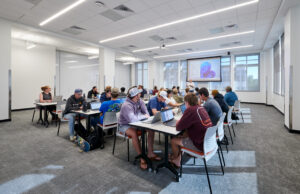
The first floor features central core elements, including a large double-height innovation lab and a 100-person general classroom. The second floor houses administrative functions and offers public lounges, study spaces, and collaboration areas that overlook the two-story Innovation Lab. The third level comprises a large studio and classroom area that can be subdivided with operable partitions to break the space into smaller classrooms and support small-group collaboration. Here, students work on capstone projects as part of larger groups.
The building’s interior puts building systems on display, helping construction students visually understand everything from mechanical, electrical, and plumbing components to more traditional systems such as ceilings and walls. The school’s BAS (building automated system) also offers smart features that allow research groups to track the overall performance of the building, and classrooms are adorned with a variety of learning technologies.
The most impressive learning tools, however, are located in the high bay research lab, known as the Innovation Lab. The Innovation Lab includes a 5-ton bridge crane and two smaller 1-ton job cranes, which are primarily used for lifting large wall mockups. The development of the Innovation Lab also helped the University secure a grant for a large 3D concrete printer that allows the program to do research on 3D-printed buildings.
The project was particularly significant for W.M. Jordan, as the company has a longstanding relationship with the Myers-Lawson School of Construction and employs several Hokie graduates.
“Creating this much-needed space and having the opportunity to leverage this project as a learning tool for class discussions, site tours, and a part of our internship program — which is in its 30th year — made this project incredibly impactful for our company and project team,” said Scott Brame, construction manager with W.M. Jord. “In addition, throughout our organization, we have many construction professionals are graduates of the program, and we relished the opportunity to directly improve the resources of a program that is hugely impactful to our industry and our company.”
W.M. Jordan had four student interns involved in the project. One student focused on virtual design and construction and helped with BIM coordination; another worked closely with the project engineer learning the process of RFIs and submittals; and two worked with superintendents on short-term scheduling learning field coordination and the inspections/QC processes.
“Being able to provide this very real, hands-on experience concurrent with their studies greatly enhances their knowledge and understanding of all aspects of building construction,” Brame said. “The well-rounded skill set they develop through this process also significantly enhances their job opportunities following graduation.”
Student Dining Spaces
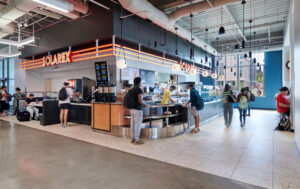
Meanwhile, the southern portion of the building introduced Perry Place, a bustling dining hall that houses nine distinct dining venues with seating for more than 700 diners. Perry Place is a fresh take on the traditional student dining hall, offering a wide variety of modern dining options that reflect students’ changing tastes and expectations. Diners can choose from a sustainability-focused coffeehouse, an authentic smoked BBQ restaurant, Asian street food, an all-day breakfast diner and more. Perry Place also provides a chance for the University to practice its commitment to sustainability, prioritizing compostable food containers, napkins, straws, cups, lids and silverware and BPI-certified paper. Recycling and compost bins are located throughout. The building’s dining spaces also integrated newer technologies, including mobile phone ordering and kiosks.
Building Connection
Linking these two unique spaces and functions is a double-height space with open views to dining venues on both floors. A bridge also connects the second floor of the School of Construction and the building’s southern wing dining hall. The two-story Innovation Lab is on display through windows in the linking section, also giving the school a clean construction prominence. This linking section also offers offices and conference rooms on the third floor.
The structure was also designed to harmonize with the rest of the growing campus. For example, the Myers Lawson School of Construction portion of the building includes a tower that has similar architectural proportions and features to its partner tower at the adjacent Bishop-Favro Hall, which also houses construction and engineering program courses. Meanwhile, the east and west towers of the dining and provost classroom side of Hitt Hall are designed to be more traditional collegiate gothic in character.
“The initiation of the two wings is also distinct,” Amos said. “While different, the two buildings talk to each other. The interiors are similar; however, each dining venue has its own unique identity and brand.”
One key element that helped guarantee success was the use of pull planning to help build a sound, coordinated schedule in collaboration with trade partners, Brame explained. This process brings all key construction trade partners together to develop a schedule that works logically and has right workflow to complete the project on time. This tool, in conjunction with daily field leader huddles and weekly tracking, allowed the project team to overcome every hurdle and complete the project as scheduled.
Material Selection
Following the Covid-19 pandemic, long lead times on materials led to changes in mechanical, electrical and plumbing equipment and interior finishes selections for the project. After reviewing submittals for one product, the team often had to work with the construction manager to find and substitute other products in order to keep the project moving. Throughout the project, the design and construction team quickly identified potential schedule slips and worked diligently to resolve them so that the project stayed on track for the fall 2024 opening.
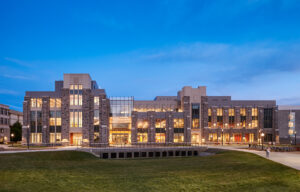
The exterior of Hitt Hall uses the Virgnia Tech’s signature “Hokie Stone” a local dolomite that adorns nearly all buildings on campus. Additional materials include durable options such as precast concrete, aluminum curtainwalls and metal panels.
Interior materials were also selected for their durability, sustainability and — particularly in the dining portion — ease of cleaning and maintenance. Cooper Carry also leaned into the concept of construction elements on display with the design throughout the structure, not just in the Myers-Lawson School of Construction portion. The firm utilized an oriented strand board (OSB) sheathing as an accent wood to bring warmth into the space. The ceilings were also left open to the structure in many of the common areas to showcase the building systems.
“All hallways, public spaces, and dining areas utilize the building structure instead of added materials that will eventually be in a landfill,” Amos said.
These areas are finished with polished concrete, while classrooms and offices use carpet tiles with high recycled content. Bathrooms and kitchen areas use easy-to-clean, recycled tiles. The building also has several security features such as updated door hardware, safety notification systems, ballistic film on windows and fail-secure locks.
Celebrating Success
Hitt Hall was one of multiple buildings to open recently in the University’s North Academic District and as part of the Virginia Tech’s Campus Master Plan. The project was required to meet LEED Silver certification as a minimum; however, the design team was able to achieve more points than requested and the project is tracking Gold-level designation.
“Hitt Hall is a welcomed addition to the North Academic District,” said Travis Jessee, interim assistant vice president for design and construction, in a statement announcing the project’s completion. “The collaboration and dedication of Cooper Carry and W.M. Jordan have ensured a highly coordinated and intentional development process in a highly trafficked area. I’m excited to see future generations of Hokies enjoy this space.”
“I’m a person who is passionate about construction and the positive impact that we create within the communities of our projects,” Brame added. “I have benefited in my career by having experienced professionals who were willing to take time to teach me how things work … and generally helping to guide me to be successful. This project provided an avenue to increase mentorship and knowledge sharing with our next generation of construction field leaders, and that makes me exceptionally proud of our work on Hitt Hall.”
For Cooper Carry, the project was significant in that it exemplified the firm’s commitment to creating spaces that foster innovation, collaboration and community. Looking to future higher education design projects, Amos and colleagues believe that high-tech, multipurpose buildings of this nature will become more common on university campuses and are happy to offer Hitt Hall as a model of cost efficiency and design innovation.
Key Project Partners:
Owner: Virginia Tech
Architect: Cooper Carry
Contractor: W.M. Jordan
MEP Engineer: Newcomb and Boyd
Food Service Consulting: Food Strategy Inc.
Structural Engineer: Lynch Mykins
Civil Engineer: Hurt and Proffit
Owner’s Representative: Forella
Landscaping: LandDesign
Sustainability: SDC


